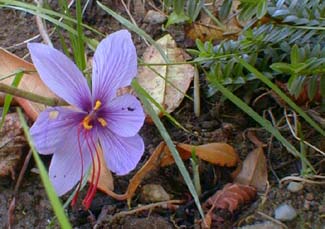
'Cashmerianus'
or Kashmir Crocus
'Cashmerianus,' named for Kashmir, India, where saffron crocus is grown as a spice crop, is more free-flowering than regular Crocus sativus & better adjusted to temperate climates, hence an improved choice for cooler or maritime gardens.
Having both the regular species & this cultivar in different locations in the gardens, I was not able to see a physical difference between the two in physical appearance, but 'Cashmerianus' has definitely spread a great deal faster, producing bulb offsets like a son-of-a-gun.
To do well indefinitely, Saffron Crocus ought to be lifted from the soil as often as annually in warm climates, or once every two to five years in cooler climates, & on average every third year. When dug up annually, the offsets are separated, & replanted immediately in light soil; if dug up at longer intervals there will be newly matured corms as well as many cormlets to separate. If they are never lifted at all, this crocus will eventually stop blooming. Saffrons never produce seeds, hence no seedlings, & are wholy reliant on human cultivation to persist.
Saffrons are a bit odd in that they reproduce rapidly if planted three to five inches deep, with lots of grass but flower poorly; whereas, if planted a full eight inches deep, they reproduce more slowly & flower very well. It's best to plant them deeply to get maximum flowering, & since they won't reproduce quite so fast, they need not be lifted as often.
Some species of autumn crocuses don't produce grass until spring, so they have nothing to support their fall flowers. Saffron Crocus does produce grass in autumn, then has flowers appearing rapidly on the heals of the tight little clumps of crocus-grass. Its own grass isn't quite substantial or tall enough to invariably uphold the blooms, however, & it is best to have it growing out of a little groundcover -- a groundcover that will not mind itself being disrupted when it is time to lift the bulbs. I would recommend one or another of a dwarf evergreen or semi-evergreen thyme, such as lemon thyme which loves similar growing conditions & can be sheered back without injury when it comes time to lift the saffrons.
They require a sunny warm slope to flower well. Buds will not fully open if left in shade. Indeed the buds won't open even if there are many days of heavy cloudcover.
The saffron crocus is not regarded as the easiest of the autumn-blooming crocuses, being much less forgiving than C. speciosus especially if located in conditions imperfect to its needs. But neither is it so difficult it ought be forsworn, & for 'Cashmerianus,' the chance of fully perennializing is heightened.
Bulbs planted in autumn bloom tepidly the first year, being at most a few weeks in the ground; but they will show themselves dramatically the following October.
The spice derived from saffron crocuses is so valuable that today it is mainly sold only in adulterated forms; it is often only minor ingredient in anything labeled "Saffron." Such extreme adulteration in former ages could have been a capitol crime. In 1444 at Nuremberg, Jobst Findeker was found guilty of selling adulterated saffron. He was sentenced to burn to death in the same fire with his condemned spice.
A spice this rare inevitably became well-known as a cure-all for the medicine cabinets of anyone sufficiently wealthy to obtain it, & this has been so for thousands of years. Among the Minoans & Phrygians, this flower was sacred to the Mother Goddess, whose priestesses & galli priests wore garments dyed red & yellow with a dye made of saffron. For a detailed discussion of this ancient mythology, see the page about Ancient Cultic Associations of Saffron Crocus.